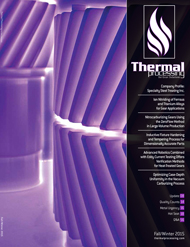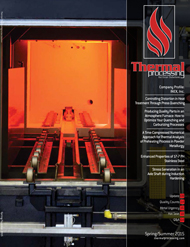Archives
September 2015
Inductive Fixture Hardening and Tempering Process for Dimensionally Accurate Parts
Automobile manufacturers increasingly require components with greater accuracy for use in sophisticated applications. To meet these increased requirements, press hardening was developed, and there are continued advancements in this field of applications. Inductive fixture hardening EMA-Indutec developed a new process that combines the benefits of induction heating/hardening with the advantages of a fixture or press […]
Nitrocarburizing Gears Using the ZeroFlow Method in Large-Volume Production
Retort-based nitriding and ferritic nitrocarburizing have been around a long time. Modern day challenges include providing known, repeatable hardness and surface case structures with the lowest possible investment and cost. While combining these factors may be difficult for equipment manufacturers, experience in designing equipment for challenging applications helps ensure meeting customer requirements. Here is a […]
Ion Nitriding of Ferrous and Titanium Alloys for Gear Applications
Thermochemical surface engineering is effective in improving the performance of various gears made of ferrous alloys [1-5]. The cost of machining typical gears during the manufacturing process often exceeds 55 percent of total cost, especially when there is significant grinding after carburizing the gears [5]. Therefore, improvements in the manufacturing of gears that can lead […]
Advanced Robotics Combined with Eddy Current Testing Offers Verification Methods for Heat-Treated Gears
Eddy current is a nondestructive testing technique proven for use in heat treatment and material structure verification. Modern multifrequency eddy current instruments can test for conditions such as misplaced case, shallow case, short heat, short quench, and delayed quench. Gears, bearings, axles, shafts, and other components are heat treated to develop the required strength and […]
Optimizing Case-Depth Uniformity in the Vacuum Carburizing Process
Over the past few decades, the vacuum carburizing process has been proven to produce superior part quality. In addition, the use of vacuum technology for carburizing has the most potential to improve the manufacturing process by reducing both processing time and the number of manufacturing steps required to produce a part [1]. These savings are […]
April 2015
Controlling Distortion in Heat Treatment Through Press Quenching
Introduction Press quenching is a specialized quenching technique that may be utilized to minimize the distortion of complex geometrical components during heat treatment1. Distortion is routinely encountered in industrial heat treating operations, and is an especially important consideration where high accuracy, precision components are concerned. It can result from a wide variety of independent contributing […]
Producing Quality Parts in an Atmosphere Furnace: How to Optimize Your Quenching and Carburizing Processes
Throughout the manufacturing process, heat treatment is consistently viewed as a critical step for adding value to the parts produced. A part expensively manufactured by melting, hot rolling or forging, annealing, rough machining, teeth cutting and grinding is of little or no value without final heat treatment to produce the required metallurgical and mechanical properties. […]
A Time-Compressed Numerical Approach for Thermal Analysis of Preheating Process in Powder Metallurgy
Introduction Recent developments have been made in the field of powder metallurgy of materials to obtain advanced properties as compared to conventional manufacturing of materials for various applications. Powder metallurgy offers several advantages like improved strength and dimensional stability resulting in near net-shape products. Development of powder metallurgy techniques has resulted in new primary and […]
Stress Generation in an Axle Shaft during Induction Hardening
Introduction Induction hardening of steel components offers a fast heating rate, high efficiency, and the ability to heat locally. Induction hardening is a highly nonlinear multi-physical process with electro-magnetics, temperature, phase transformation, stress, and shape changes all occurring in the component. Compressive residual stress in the hardened case is beneficial to the high-cycle fatigue performance. […]
Enhanced Properties of 17-7 PH Stainless Steel
Background Precipitation-hardening (PH) stainless steel grade 17-7 PH is classified as a semiaustenitic stainless steel used extensively in aerospace and finding new applications in the medical industry. The material is most often used in sheet and strip form with springs, clips, and bellows being widely produced. The high alloy content of 17-7 provides excellent corrosion […]

























